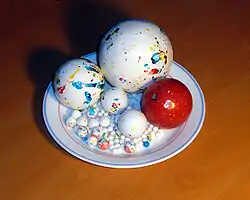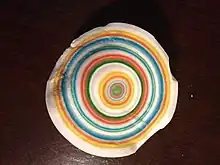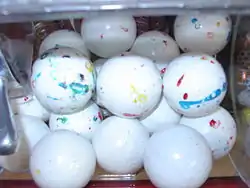Gobstopper
Gobstoppers, also known as jawbreakers in the United States and Canada, are a type of hard candy. They are usually round, and usually range from 1 to 3 cm (0.4 to 1.2 in) across; though gobstoppers billed as having a diameter as large as 3.25 in (83 mm) have been marketed.[1]
 Gobstoppers of various sizes and colors. The largest one is 3 inches (~7.5 cm) in diameter | |
| Alternative names | Jawbreaker, Jawbuster |
|---|---|
| Type | Confectionery |
| Place of origin | United Kingdom |
| Main ingredients | Sugar |
The term gobstopper derives from "gob", which is slang in the United Kingdom and Ireland for mouth. The sweet was a favourite among British schoolboys in the first half of the twentieth century—author Roald Dahl, who wrote about a jar of gobstoppers featuring in the prank he played in his local sweet shop in 1923, also referred to them in his fictional Everlasting Gobstopper which was featured in his 1964 children's novel Charlie and the Chocolate Factory.[2]
Gobstoppers usually consist of a number of layers, each layer dissolving to reveal a differently colored (and sometimes differently flavored) layer, before dissolving completely. Gobstoppers are too hard to bite without risking dental damage (hence the name "jawbreaker").
Gobstoppers have been sold in traditional sweet shops for at least a century, often sold by weight from jars. As gobstoppers dissolve very slowly, they last a very long time in the mouth, which is a major factor in their popularity.
Manufacturing

Gobstoppers are made by slowly depositing layers onto a core (such as a pressed ball of sugar, a single seed of anise or a gumball).[3][4] Gobstoppers are made in large, rotating, heated pans in a process known as "hot panning". The candies take several weeks to manufacture, as the process of adding liquid sugar is repeated multiple times. Natural and artificial colors and flavors are also added during the panning process.
Everlasting Gobstoppers
The Everlasting Gobstoppers, sold under Nestlé's Willy Wonka Candy Company brand, were first introduced in 1976 by Breaker Confections,[5] and are named after the Everlasting Gobstoppers in Roald Dahl's children's book Charlie and the Chocolate Factory. In Dahl's story, Everlasting Gobstoppers are purported to last forever. Dahl named the sweet after gobstoppers, which were a favourite among British schoolboys between the two World Wars.[2] A jar of gobstoppers featured in the prank Dahl played on the owner of his local sweet shop in 1923, which he recorded in his autobiography Boy: Tales of Childhood.[6]
In popular culture
Charlie and the Chocolate Factory
In the 1964 children's book Charlie and the Chocolate Factory, British author Roald Dahl described "Everlasting Gobstoppers," a fictional gobstopper that could never get smaller or be finished.
Ed, Edd n Eddy
The animated series Ed, Edd n Eddy revolves around jawbreakers. Most episodes feature the title characters running a variety of scams to earn money to buy the confections.[7] The jawbreakers in the show are depicted as comically oversized, often with a circumference larger than that of the heads of the characters;[1] characters' cheeks would balloon to the same size when these jawbreakers were placed in their mouths. Jawbreakers are also the main subject of one of the show's tie-in video games, Ed, Edd n Eddy: Jawbreakers![8]
Jawbreaker
The 1999 American teen black comedy Jawbreaker centers around the main characters accidentally killing their friend after gagging her with a jawbreaker.
Notable incidents

In 2003, Taquandra Diggs, a nine-year-old girl in Starke, Florida, suffered severe burns, allegedly from biting on an exploding Wonka Everlasting Gobstopper that had been refrigerated, left out in the sun, then refrigerated again. Diggs and several other alleged victims' families filed lawsuits against Nestlé for medical bills resulting from plastic surgery as well as pain and suffering; the matters were later settled outside of court for an undisclosed amount.[9][10]
References
- Stone, Lillian (September 8, 2021). "Tackling an Ed, Edd n Eddy–sized jawbreaker is a fool's errand". The Takeout. Retrieved June 25, 2023.
- Ayto, John (2012). The Diner's Dictionary: Word Origins of Food and Drink. Oxford: University Press. p. 154. ISBN 978-0-19-964024-9.
- How it's Made Season 7 Episode 02
- Walter, Eugene (2001). Hints & pinches. Athens, GA: Hill Street Press. p. 18. ISBN 9781892514981.
- Zeldes, Leah A. (October 30, 2009). "Willy Wonka lives in Chicagoland". Dining Chicago. Chicago's Restaurant & Entertainment Guide, Inc. Archived from the original on November 4, 2009. Retrieved November 4, 2009.
- "Blue plaque marks Dahl sweet shop". BBC. Retrieved 24 December 2014.
- "It's 20 Years Since 'Ed, Edd n Eddy' Was First Released". LadBible.com. January 5, 2019. Archived from the original on August 8, 2019. Retrieved June 25, 2023.
- Harris, Craig (April 9, 2003). "Ed, Edd n Eddy: Jawbreakers". IGN. News Corporation. Archived from the original on November 3, 2012. Retrieved June 25, 2023.
- "Florida Girl Injured In Bizarre Candy Episode". The Smoking Gun. 2011. Archived from the original on February 13, 2011. Retrieved February 21, 2011.
- "Jawbreaker Candy Explodes, Burns Fla. Girl's Face". WKMG Orlando. 2011. Archived from the original on August 11, 2011. Retrieved February 21, 2011.
External links
 Media related to Gobstoppers at Wikimedia Commons
Media related to Gobstoppers at Wikimedia Commons